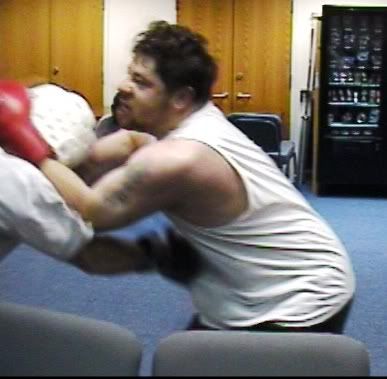
A good RealFighting.com article by Gracie Black Belt John Danaher, called "Fighting in the Clinch: A Key Skill in Real Fighting"
Why is fighting in the clinch important?
In most real fights, technical skill and experience in the clinch is crucial in determining the outcome. Strangely enough, the truth of this message is largely lost upon most martial artists and fighters. It is probably fair to say that across the board of martial arts, less time is spent training clinch skills than any other phase of unarmed combat.
We must begin by detailing just what a clinch is, then look at why it is so crucial in real fighting, why it has gotten so little attention among martial artists for so long and finally, how one can raise his or her skill level in this all-important phase of combat?
What is a clinch? Let us initially define a clinch as any situation where both combatants are standing and have some kind of grip upon each other. This definition is deliberately vague enough to convey the idea that clinches come in many different forms. The common factor is that the grip upon an opponent allows each fighter to control, pull, push, off-balance and restrain the other. This might begin with a simple wrist grab. It increases in complexity and control all the way up to headlocks, bodylocks etc. etc.
Once in a clinch, the fighters can no longer move as they please, but must now take the other fighter's grip and control into account as they attempt to fight.
Look at any combat sport, even those that do not involve any grappling, such as Boxing, Olympic Tae Kwon Do, point Karate, kick boxing etc. etc. Note how often the two fighters come into body contact as they fight. Each time they lock up, the referee breaks them apart and the game resumes. In a real fight, there is no referee to break the clinch. In this sense, in a real fight, the action really begins to get serious when the clinch is locked.
Unlike sport fights, street fights almost always begin with some kind of (negative) social interaction. Both combatants try to intimidate, harass and insult the other. As they do so they usually press up into very close range, posturing and using body language to intimidate the other person at an "in your face" distance. It is at a range as close as this that most street fights begin.
It is no exaggeration to say that such fights begin in the clinch (An interesting side note: In my own bouncing experience, my best results against mass attack involved clinching the most aggressive attacker and driving him right through the attacking group, keeping so tight that there was little opportunity for his comrades to hit me anywhere except the back - in the fast pace of the action I was often able to punch through the group and get to an improvised weapon (such as a chair or barstool) to even things up. Ironically then, the clinch often saved me rather than hindered me in cases of mass attack - the exact opposite of what most experts claim).
...we might make a list of fighting styles that strongly emphasize clinch work and observe their respective strengths and weaknesses.
Western Boxing - very good at entering into a clinch against punches. However, the rules of boxing stop the fighting as soon as the clinch is attained, so there is absolutely no strategy once the clinch has actually been arrived at.
Thai boxing/Bando - strong on entering the clinch, off-balancing in the clinch and striking (knees and elbows) in the clinch. However, most of the clinch work revolves only around the head and neck, takedowns are not emphasized and submissions are illegal.
Judo/Sport Brazilian jiu jitsu - Strong on clinching with a jacket. Gripping and off-balancing skills are very impressive, as are throws, submissions and takedowns. However, clinching without a jacket is not worked, nor are strikes and entries to the clinch.
Greco-Roman wrestling - the best of the Western wrestling styles in upright clinch fighting due to the fact that only upper body holds are permitted. Extremely effective in non-jacket gripping skills, off-balancing, powerful throws and takedowns. Lacking however, in lower body takedowns, submissions, entries and strikes.
Read the rest.
Free-style wresting - the clinch is much less important in free-style than Greco-Roman. Level changing down and shooting into leg attacks is strongly emphasized. Still, there is a lot of tie-ups and clinching along with attacks to the legs in the clinch. Striking, entries and submissions are not part of the sport at all, however.
Relevant Links:

3 comments:
Wow !!! What a nice and brilliant idea...why don't you try www.xkeroncong2006.blogspot to see some different way of expressing an idea. As you can see a picture can represent a thousand words...
to have well devloped boxing foot work such as four directinal stepping and piviot step turns and basic greco roman pummeling sills is a
god send for andy muay thai trainer..
just think how expidicously one could assend the sills of muay thai with g-r and western boxing!!
brinkka2011 says: Informative post, Im now one of your feed followers
Post a Comment